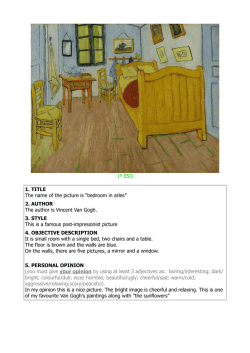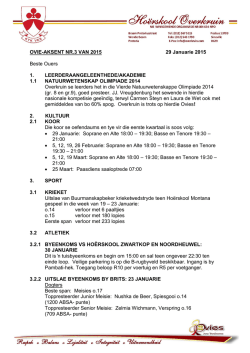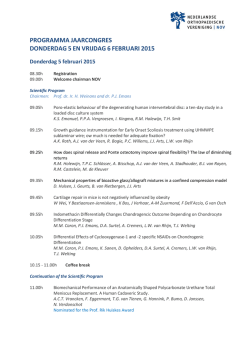
sample pages - University of Chicago Press
Van Gogh The Asylum Year Edwin Mullins On May 8, 1889, Vincent van Gogh committed himself to the Saint Paul Asylum in Saint-Rémy, an isolated estate where he remained as a voluntary patient for a full year. Throughout this time, Van Gogh kept up a continuous correspondence with his brother Theo about his art, mental condition, hopes, and ambitions, along with his despair and sense of failure. His asylum year was Van Gogh’s most raw and desperate period, yet also his most creative, producing nearly a masterpiece a day. He painted many of his most famous works at the asylum, such as The Round of the Prisoners, Sorrowing Old Man, and Starry Night. In Van Gogh: The Asylum Year, Edwin Mullins offers a month-by-month account of that crucial penultimate chapter in Van Gogh’s life. Mullins examines this period as a self-contained episode, unique within the history of Van Gogh’s artistic genius. Containing an excellent variety of paintings and sketches from that year, correspondence with his brother, and extensive biographical and historical material, this book is a magnificent study of this most impassioned and prolific year. Edwin Mullins is an author and broadcaster who has served as the art critic for the Daily Telegraph and Sunday Telegraph. 63/4 x 91/2, 144 pages, For a review copy or other illustrated in color throughout publicity inquiries, please contact: Kristen Raddatz, PromoISBN-13: 978-1-910065-53-2 tions Manager, University of Chicago Press, 1427 East 60th Publication Date: February 2015 St, Chicago IL 60637. Email: [email protected]; Cloth $30.00 Telephone: 773-702-1964; Fax: 773-702-9756. To place orders in the United States or Canada, please contact your local University of Chicago Press sales representative or contact the University of Chicago Press by phone at 1-800-621-2736 or by fax at 1-800-621-8476. van gogh the asylum year Edwin mullins Fountain in the Asylum Garden (detail) Saint-Rémy-de-Provence, May 1889 Unicorn Press Ltd 24 | Van Gogh The Asylum Year The Last Months in Arles Gogh be interned. Arles was a tight provincial community little used to foreigners or artists, least of all to foreign artists given to strange behaviour and violent outbursts. Disturbed and angry, he returned to the safety of the hospital. A man who began to figure prominently in Vincent’s life at this time was the local Protestant pastor, the Rev. Fréderic Salles. Van Gogh’s early apprenticeship with a view to becoming a cleric and preacher in the Protestant Reformed Church in Holland brought him naturally close to the man who was its local representative here in Arles. Salles made efforts to take Van Gogh under his wing, besides acting as a link between Vincent and his brother Theo in Paris, especially in periods when Vincent himself was too stressed or unwell to write letters. One such interval occurred during the first weeks in March, when it was left to the Rev. Salles to inform Theo of Vincent’s new misfortunes. ‘I learn that you are not yet better, which causes me much grief,’ Theo wrote on March 16th after hearing from Salles. The letter prompted Van Gogh to break his silence; and over the following weeks letters to his brother follow one after the other in rapid succession in a positive lava-flow of his thoughts and fears. Reading this painful outpouring to his brother it becomes clear that it was at this time, in the wake of his second mental breakdown, that Van Gogh’s life had reached a turning-point from which there could be no retreat. His days as a free and independent human being were over; and it becomes ever more obvious that an asylum beckoned. The letters show a man desperately trying to harness his intelligence to understand the kind of person he has become. He tells Theo of the petition claiming him to be ‘a man not worthy of living at liberty’, which he finds ‘a hammer blow in the chest’. Under pressure from the local police chief he is confined to an isolation cell in hospital: ‘Here I am shut up day after day under lock and key.’ He knows he must resist getting angry about it, aware that he would otherwise be judged ‘a dangerous lunatic’. He writes about ‘feeling calm’, while aware that at any moment he could ‘fall back into a state of over-excitement’. In dozens of letters over the months, to become ‘calm’ is forever the Self-portrait with Bandaged Ear and Pipe Oil on canvas, 60 x 49 cm Private collection (Stavros Niarchos), on loan to Kunsthaus Zürich | 25 36 | Van Gogh The Asylum Year trees and cypresses to come later in the year, have been transformed into art. The lightning and the lightning conductor had done their job. (Irises was a painting which especially pleased Theo when he received it in July and in September Theo arranged to include it in the annual Salon des Indépendents in Paris, where puzzlingly it was entitled A Study of Geese.) Irises Oil on canvas, 71.12 x 93 cm Getty Centre, Los Angeles May 1889 | 37 In that same first week at Saint-Rémy, Vincent also made a number of large drawings of the asylum garden with its trees and undergrowth, stone benches and circular fountain. Some of them were enhanced with watercolour or gouache and generally executed in pencil, black chalk and his favourite drawing implement, the reed pen. This pen was ideal for the short stabbing strokes which he preferred and which characterise his drawings of this period. True to the tradition of the Dutch Old Masters who invariably valued drawings for their own sake, all these new drawings of the asylum garden were conceived as finished works in their own right, not as preparatory studies for a painting or (as so often) a record of a painting to show Theo what he had been doing. He was also keen to show his brother the sort of place in which he was now living. Theo, after all, was paying for it all – not just for the asylum and Vincent’s upkeep there, but for his paints, brushes and rolls of canvases. In addition he was also trying, with limited success, to interest clients of the Goupil Gallery where he worked, in Vincent’s paintings, as they arrived in repeated batches at his Paris apartment. It must have seemed a thankless task. Brotherly love was mutual between Vincent and Theo, but brotherly support was heavily one-sided. Vincent wrote to Theo during that first week in the asylum. The letter was uncharacteristically brief; none the less it was a fairly cheerful one. ‘I want to tell you that I think I’ve done well to come here,’ he says. He goes on to tell Theo how glad he is to see ‘the reality of mad people’s lives’ though he is beginning to think of madness as ‘an illness like any other’. He mentions the irises, ending on the need he feels to be able to work and how it totally absorbs him when he is painting, blotting out all dark thoughts. On the same day in a much longer letter to his sister Wil, Vincent expands on what it is like living among mad people, how he continually ‘hears shouting and terrible howling like animals in a menagerie’. On the other hand he notices how the patients help each other at moments of crisis and when they stand around watching him paint in the garden they are discreet and polite unlike the people in Arles. He 50 | Van Gogh The Asylum Year The Starry Night. Oil on canvas, 73.7 × 92.1 cm The Museum of Modern Art, New York – Acquired through the Lillie P. Bliss Bequest. June | 51 would soon be assured. Instead Van Gogh had painted what he describes to Theo as ‘a study of a starry night’. How welcome this must have sounded to Theo’s ears: yet it is hard to imagine a painting that conformed less to Theo’s request for nothing more than ‘a simple account of what you see’. No other artist has painted a night sky quite like this and understanding it poses a problem. Had it been an account of a dream, or a vision born of the imagination of William Blake or Hieronymus Bosch, it would have been easily acceptable on those terms. But Van Gogh’s night scene was presented as real: this was how the artist saw it one night from his bedroom window, or so we are asked to believe: it was simply ‘a study of a starry night’. It seems to be a tranquil rural scene. A sleeping village clustered round a church with a tall spire rests among low hills. In the foreground a pair of cypress trees thrusts upwards into the night sky. At this point we enter a quite different world. A soft veil of light is draped across the hills. An orange crescent moon glows within a golden halo and across the vast night sky a wild ballet of stars is being performed. Constellations spin like illuminated Catherine-wheels in a vortex generated by some gigantic force of nature belittling our humble existence down below. Needless to say stars do not spin like this except in the mind. So, what kind of vision is this? Starry Night is the best-known of all Van Gogh’s paintings from Saint-Rémy and theories about the meaning of its celestial ballet have gathered momentum for more than a century. Among them has been the familiar claim by art historians that Vincent was emulating Gauguin – a view hard to substantiate: stylistically the picture has remarkably little to do with Gauguin and a great deal to do with what was going on in Van Gogh’s head. More fanciful interpretations include a supposed debt to the Old Testament (Genesis), the New Testament (the book of Revelations) and to the writings respectfully of Longfellow, Walt Whitman, Emile Zola, Alphonse Daudet, Charles Dickens and Uncle Tom Cobley and all. A recent biography evokes scientific evidence to suggest that Van Gogh’s night sky represents a mental firework display of a kind created by 78 | Van Gogh The Asylum Year emphasised by the unhealthy greenish shadows lingering on the skin. It is not an image of himself that radiates self-assurance: rather it is a portrait of a man plagued by doubts and fears. He may be proud to present himself as a painter; yet the world he has devoted his life to painting, the wide world outside the asylum walls, is now too frightening a place for him to enter. If there is a message in this selfportrait it is one of hope overshadowed by self-doubt, rather than selfconfidence. (The painting also carries an echo of an earlier Dutch artist, who like Van Gogh fell on hard times, Rembrandt van Rijn. Like Van Gogh Rembrandt defined himself proudly as a painter, that was what he was and proud of it! Among his many self-portraits is one of the artist, similarly holding his palette and brushes before him. The painting, since the 1920s part of the Iveagh Bequest at Kenwood House in London, was in England at the time of Van Gogh’s extended stay in London as a young man and he would certainly have known of it, at least in reproduction. Among the Old Masters, Rembrandt was the artist Van Gogh admired most. One of the qualities they shared was for turning their gaze inwards upon themselves and in doing so creating self-portraits which possess a hypnotic quality of introspection and self-inquiry, portraits that seem to ask the questions ‘Who am I ?’ and ‘What makes me what I am ?’) In the same long letter to Theo, Van Gogh made an observation which describes what it is in his mind that lifts the greatest portrait paintings above the level of a mere likeness. He wrote of ‘a special category (of painting) in which a portrait of a human being is transformed into something luminous and consoling.’ For an artist obsessed as Van Gogh was with everything in flux – the passage of seasons and the fickleness of nature – perhaps the consolation in a great portrait lay in the utter certainty of the human presence. Vincent expressed a strong admiration for a number of artists whose work he knew well. Mostly these were from a generation only a little before his time, chief among them being Delacroix, Millet, Daumier and the Barbizon painters Rousseau and Diaz. Rembrandt was in a Self-portrait Oil on canvas 57.8 x 44.5cm National Gallery of Art – Collection of Mr. and Mrs. John Hay Whitney August | 79 94 | Van Gogh The Asylum Year October ‘We’ve been enjoying superb autumn days and I’m taking full advantage of them.’ Van Gogh’s buoyant letter to Theo on October 5th was in response to the letter he had received earlier that day from his brother. The glorious Provençal autumn has spurred him to seek out ‘even more beautiful subjects for tomorrow, in the mountains’. The urge to explore the mountains was one of Vincent’s more restless ambitions at Saint-Rémy, though the absence of drawings or paintings of the Alpilles except as a backdrop suggest that it was more often a dream than a reality. It seems unlikely that Dr Peyron welcomed the idea of his erratic patient wandering among the rugged peaks of the Alpilles, even with an attendant. However, the note of adventure in his reply to Theo was a response to several items of good news in his brother’s letter. The first of these was the report Theo gave him of his meeting in Paris with Dr Peyron, who had assured him that ‘he does not think you are mad at all, only epileptic and that the last crisis he believed to have been brought on by Vincent’s visit to Arles in early July. Peyron was also of the view that, while his patient was of course free to go, Vincent should remain at the asylum at least until the winter was over, in case there might be a another breakdown. Vincent seemed both relieved and in agreement with Dr Peyron’s view, though he doubted if Arles had anything to do with his illness and Trees in the Garden of the Asylum Oil on canvas, 73 x 60cm Private collection, Switzerland 134 | Van Gogh The Asylum Year January 1890 | 135 a landscape as distinct from being a painstaking attempt to copy every detail in a way that would inevitably lose the essence of it. In this way he developed a kind of pictorial shorthand – a distinctive vocabulary of dots, strokes and swirls which bear little or no resemblance to anything in nature, yet they manage perfectly to convey the essential form, texture and character of what he is describing. It may Fountain in the Garden of the Asylum Black chalk, pen, reed pen, brown ink on paper, 49.8 x 46.3 cm, Van Gogh Museum, Amsterdam before Rembrandt, of treating drawings as complete works of art in themselves and not merely preparatory sketches for a painting. Several of Van Gogh’s drawings from his Asylum Year belong in this category, including the fountain drawing which Theo so admired, as well as one of the finest of all the drawings from St-Rémy, the pen-and-ink version of Wheat fields with Rising Sun. This is a perfect demonstration of Van Gogh’s search for a graphic language capable of describing the feel of Wheat Field with Sun and Clouds Black chalk, reed pen and brown ink, heightened with white chalk, on Ingres paper, 47.5 x 56cm, Kröller-Muller Museum, Otterlo February | 145 144 | Van Gogh The Asylum Year Aurier’s view of Van Gogh would have conflicted strongly with Vincent’s own very clear opinion of his place in contemporary art and in particular of where he stood in relation to artists of the past, from Giotto and Rembrandt to Delacroix and Millet. Aurier’s flowery accolade offered the romantic view of Van Gogh as the childlike genius isolated from a world which was incapable of understanding him (a view that has widely prevailed ever since). Vincent was torn, even more than he had been by Isaacson’s more superficial article several months earlier. Quite unaccustomed to being flattered by critics, or having radical opinions on his work thrown at him, Van Gogh became haunted by Aurier’s article. For weeks and months ahead the subject would re-emerge time and again in his correspondence, usually quite out of context. Towards the end of the same long letter to Theo, Vincent returned to the subject once again, acknowledging to his brother that ‘partly because of that article I’m now feeling completely well.’ Then, in a footnote he added that he was proposing to write a letter to Aurier and hoped also to present him with a painting in gratitude for his article. The following day he expanded similar thoughts in a letter to Joseph Ginoux, the Arles cafe-owner he had seen just before his recent attack: ‘Work isn’t going at all badly, having had an article on my paintings both in Belgium and in Paris where I’ve exhibited them and people are now saying much more favourable things about them than I personally would wish.’ Self-denigration was the invariable accompaniment to Van Gogh’s pleasure at being praised. Reading between the lines, Vincent was beginning cautiously to feel that recognition was gradually coming his way. Winter weather and the aftermath of his recent attack was once again confining Van Gogh to his studio. As usual he whiled away the time making copies of his own work and that of other artists. Theo had sent him a collection of wood-engravings illustrating celebrated work by earlier artists admired by Van Gogh, which he had acquired during his time in Paris. From these he contrived to create two of the most unprepossessing canvases of his entire Asylum Year. One was a painted version of an engraving by Honoré Daumier depicting a group of beer swilling drunks, a crude concept crudely painted. The other was from a grim engraving by Gustave Doré with some forty robotic prisoners trudging round and round the cell-like yard. Unlike Van Gogh’s Prisoners’ Round (after Doré) Oil on canvas, 80 x 64 cm Pushkin Museum, Moscow May 1890 | 183 182 | Van Gogh The Asylum Year Sketch of Road with Cypress and Star Ink on paper, cm Van Gogh Museum, Amsterdam star on the other, echoing the dramatic sky of Starry Night painted nearly a year earlier. Two figures stand in the foreground on the moonlit road beside the shadow cast by the cypress tree. Approaching them on the road is a small horse-drawn carriage with another figure half-concealed beneath its canopy. The whole painting seems to be telling a story. It is a compilation of images drawn from other canvases, brought together to create a pictorial metaphor for his most deeply-felt experiences during his time at Saint-Rémy. It was Van Gogh’s salute to Provence and his farewell to it. Not until he had finally left the south did he make any reference to the painting. Then, five weeks after his departure, Vincent wrote to Gauguin, ‘I still have a cypress with a star from down there. It’s a final attempt…very romantic, if you like, but very Provençal, I think.’ In fact the canvas was still at Saint-Rémy, drying out under the care of Trabuc along with the other late paintings and the sketch Van Gogh Road with Cypress and Star Oil on canvas, 92 x 73cm Keoller-Muller Museum, Otterlo
© Copyright 2026



